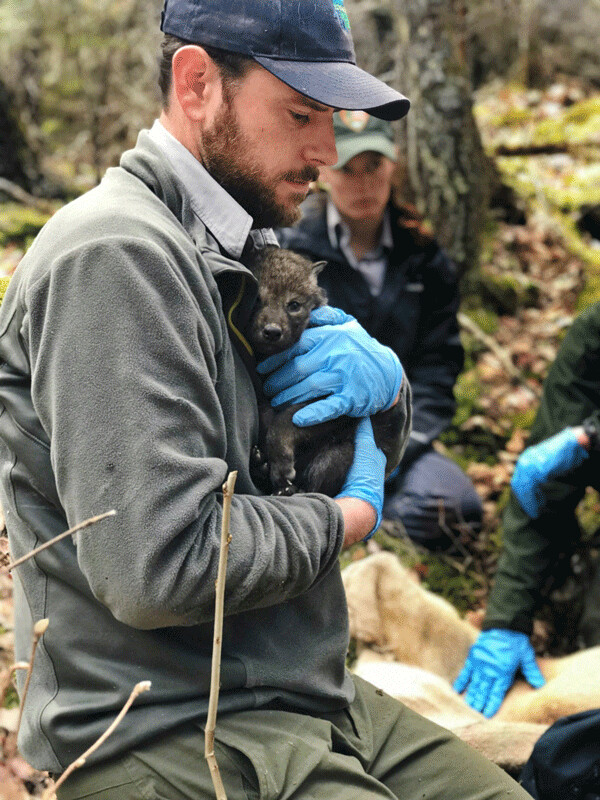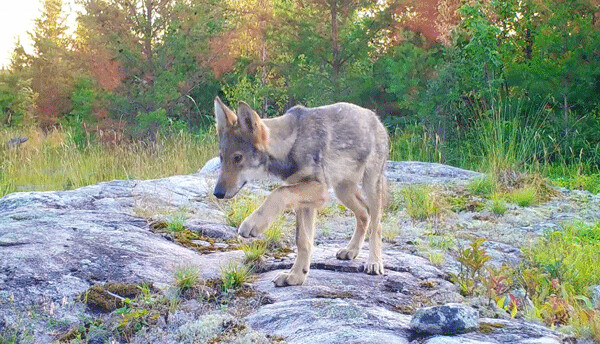News & Articles
Browse all content by date.


Bitter winds swirled icy crystals around my numb feet. At regular intervals, I spoke into the hand-held recorder about the behavior of a wolf pack milling around an elk carcass on a distant, snow-covered hill. A faint buzz grew louder as the research plane soared over the vast landscape collecting even more data.
During my stint as a volunteer with the Yellowstone Wolf Project back in March of 2008, that was a typical day in the life of a wolf researcher. With snow on the ground, wolves and their tracks are more visible, they travel as cohesive packs, and they bring down large prey (which leaves behind a noticeable mess). As a result, most of what we know about wolf predation is from the winter months.
The Voyageurs Wolf Project wants to change that. Tom Gable, project leader and a PhD student from the University of Minnesota, recently spoke about their work as an extension of Wolf Awareness Week at the Sigurd Olson Environmental Institute. Since 2015, the project has been conducting intensive research on the summer behavior of wolves in the Greater Voyageurs Ecosystem of northern Minnesota. Their field season looks nothing like my experience in Yellowstone. For starters, mosquitoes swarmed thickly in the videos Tom showed us. (Oh, how I love winter!) But what really struck me was how much more difficult it is for the researchers to find evidence of summer kills.
While I used VHF collars and spotting scopes to observe wolves, Tom and his crew rely heavily on GPS collars. With great accuracy, the collar records a wolf’s location once every 20 minutes. That’s 72 points per day. After a computer program filters the raw data, researchers get a map of every point where a wolf spent more than 20 minutes in one spot (called “clusters” of GPS locations). Potentially, the wolf paused to eat something.
Now the detective work begins. Someone from the team of researchers must visit every single pause point to investigate. So far, the project has visited 11,799 clusters from 18 wolves, which equals about 15,000 hours of field work and 16-17,000 miles of hiking.
Tom showed us a video of him investigating the site of one GPS cluster. It looked like any other brushy patch of forest: thick, shin-high plants and a rotting log across the middle. As he walks toward the kill site, we begin to see that a couple of plants near the log have been broken and their leaves wilted. Once the camera is looking directly down on the dead plants, we see a faint, oval depression where something might have sat down. Reaching down into the litter, Tom first holds the tooth of a fawn for the camera to see, and then the ebony tip of its hoof.
Finding where a single pack member “wolfed” down a tiny fawn is orders of magnitude more difficult than finding where an entire pack killed the fawn’s father. But that’s the reality of studying summer predation behavior in wolves. And the researchers are motivated, because their hard work is resulting in brand-new knowledge.
The next video Tom showed us was even more astounding. The pale wood of a fresh beaver chew on a medium-sized tree stuck out like a sore thumb. Tom placed his backpack in the oval patch of flattened leaves where he’d spotted a wolf’s bed. According to the GPS data, the wolf had spent 4 hours in this one location. Then Tom walked along the beaver’s trail to show us what the rodent would have seen on their way to work. Nothing. The wolf would have been invisible behind the trunk of a spruce tree—at least until it attacked.
All that was left of the beaver were its two front teeth and its stomach contents. Voyageurs National Park has one of the highest densities of beavers in the entire country, so it’s logical that wolves here would rely heavily on beavers for food. In fact, the average wolf in Voyageurs eats 8-10 beavers per summer. The cool part is, researchers were never sure that wolves have the behavioral flexibility to eat such varied prey, and to switch to ambush hunting when the need arose. Now we have a much better grasp on their summer predation habits—which include catching fish and lapping up blueberries as well!
I was thrilled to be part of the (mosquito-free) Yellowstone Wolf Project, which is continuing to contribute valuable information to our understanding of wolves and their communities. I’m also excited by the possibilities of the Voyageurs Wolf Project, and the discoveries that a new season of wolf research will bring. You can find out more at voyageurswolfproject.org, or follow their popular Facebook and Instagram pages to see incredible videos and get regular updates on their research.
Emily’s second book, Natural Connections: Dreaming of an Elfin Skimmer, is now available to purchase at www.cablemuseum.org/books and at your local independent bookstore, too.
For more than 50 years, the Cable Natural History Museum has served to connect you to the Northwoods. Come visit us in Cable, WI! Our new Curiosity Center kids’ exhibit and Pollinator Power annual exhibit are now open! Call us at 715-798-3890 or email emily@cablemuseum.org.
| Tweet |


